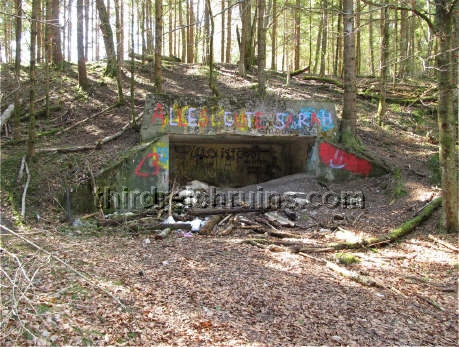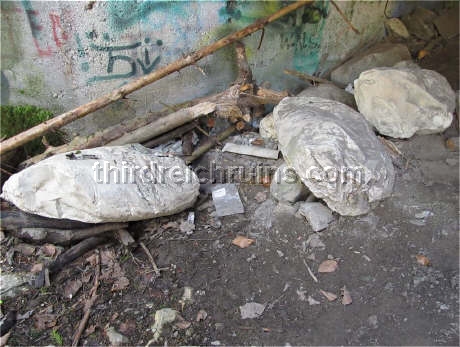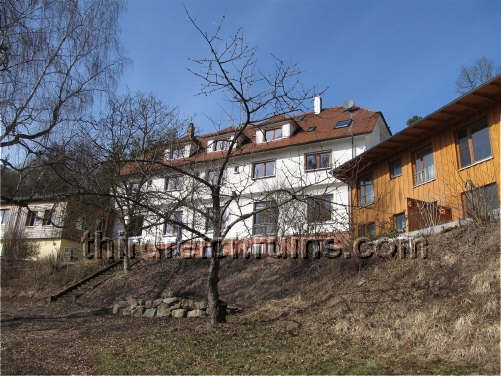|
Miscellaneous Sites
Associated with the Third Reich
Part 7
The following sites can be found
on this page: Wusterhausen an der Dosse (Brandenburg), Lienz (Tyrol, Austria),
Kulmbach (Bavaria), Geretsried (Bavaria), Deiningen
Muna (Bavaria), Heuberg Airfield
(Bavaria), Carinhall (Brandenburg), Ravensbrück
(Brandenburg), sites in Mittelfranken - Dinkelsbühl,
Rothenburg ob der Tauber, Ansbach
and Lichtenau (Bavaria); Neumarkt in der Oberpfalz
(Bavaria); Adolf
Hitler Koog (Schleswig-Holstein); Masurian Canal Locks, Poland.

|

|
| Adolf
Hitler Platz (town square) of Wusterhausen an der Dosse, from a 1930s
postcard. Note the large swastika on the front of the Rathaus (town hall). |

|

|
| Hotel Post
in Lienz, Tyrol, Austria, from a 1942-dated postcard. Note the Norwegian, Nazi, Austrian, French, and Swiss flags hanging from the hotel. The
buildings remain hardly changed today, but the hotel is now the
Altstadthotel Eck. |
-

|

|
| This 1935
postcard depicted sites in Kulmbach in northern Bavaria. The view is a
collage type, as the Plassenburg fortress on the hill is not visible from
the Marktplatz with the old City Hall (Rathaus) in view like this. (period
postcard courtesy James Lees) (Google
Maps link) |
Geretsried

|

|
| A large
factory area for the manufacture of explosives and munitions was
established along the Isar River at Geretsried, south of Munich, in
1938-41. This was actually two separate projects, codenamed "Tal
I" and "Tal II," the northern part ("Tal I") used
for the manufacture of high explosives and fuses, while the southern part
("Tal II") was used mainly for munitions assembly and storage.
After the war most of the factory buildings and bunkers were destroyed,
but some of the buildings are in use today for other purposes, and several
bunker ruins remain. Shown above are the ruins of Bunker 356, for the
manufacture of picric acid, a high explosive filler for artillery shells.
This bunker ruin is commonly known today as the "Blauer Bunker"
due to the predominant color of its graffiti. (Period references sometimes
refer to this explosives factory area as Wolfratshausen, because it was
built in the Wolfratshausen forest, but the area is today part of
Geretsried.) (Google Maps
Link)
The bunker ruin shown below is on the far
northern part of "Tal I." The objects on the right are
"petrified" bags of cement - bags of cement mix that were
abandoned outside the bunker entrance in 1945, and subsequently hardened
from rain water (a not unusual sight at several Third Reich tunnel
projects that were unfinished when the war ended).
|

|

|

|

|
| The Muna
bunker area of "Tal II" includes the ruins of this blown-up
concrete guard shelter. This bunker was of a style similar to the "Moll
Bunkers," but it was meant for only one man. (Google Maps
Link)
|
Deiningen
and Flugplatz Heuberg

|

|
| The
command and control complex was located at the southeast side of the site.
Several of the period buildings have been renovated and are still in use.
A small concrete guard bunker can be found at one entrance to the site.
(Google Maps
Link) |
 |
 |
 |
| A
small ammunition storage area was located at the south side of the
airfield. This site consisted of two above-ground brick storage
buildings and two earth-covered Muna-style bunkers. The Muna-style
bunker shown above had its doorway broken out to enlarge the entrance,
but the other bunker below is almost intact, including the outer solid
metal bunker doors and the inner metal mesh screen doors. This bunker
also had a small room in the back corner, perhaps for working with
fuses. (Google Maps
Link) |
 |
 |
 |
Carinhall

Reichsmarschall
Hermann Göring built a country estate in the Schorfheide forest north of
Berlin, naming it for his first wife Carin, who had died in 1931 (the name
is sometimes given as Karinhall).
Originally envisaged as a rustic hunting
lodge, Carinhall gradually grew into a grandiose residence, as shown above
(although the complex was never completed to the state seen here).
The buildings
were blown up by Göring's order in April 1945, and the ruins were later
cleared by the East German government. (plan by architect
Friedrich Hetzelt, Haus der Deutschen Kunst)
Ravensbrück
Concentration Camp
Sites
in Mittelfranken
-
-

|

|
| This
pre-war building on the Bocksberg hill near Ansbach was used as a Hitler
Youth home. The photos above show visiting Hitler Youth groups from
Austria and the Saarland in 1938. In 1944 the building was converted for
use as a children's home for the Lebensborn project. Today it is a guest
house and restaurant. (Google Maps
Link)
|

|
-

|

|
| Near
Ansbach is the town of Lichtenau, with a medieval walled fortress. From
1933-37 this fortress served as the headquarters of the Reichs Arbeits
Dienst (RAD) Abteilung 1/282, "Der eiserne Kanzler" (named for
Bismarck, the "Iron Chancellor"). The period photo shows the
appearance of the courtyard side of the western bastion before about 1938
(note the flags and the large swastika on the top of the bastion). In the
late 1930s the fortress underwent a complete remodeling, designed to
return it to its 17th century appearance, in preparation for a planned SS
Junkerschule (which was never established). This considerably changed the
look of the interior, but the view on the right above is the same as the
period view. Abteilung 1/282 moved to Neustadt
an der Aisch in 1937. (Google
Maps link)
|

|
-
Adolf
Hitler Koog
 |
 |
| Adjacent
to the Neulandhalle is a lawn that is reached through a period stone
gateway, with a memorial stone for World War II soldiers, "Our
Comrades." |

|

|
| These
period images show other farm buildings. The farmstead on the right, seen
flying a swastika flag in the mid-1930s, still exists, but it is so
completely surrounded by trees that a modern comparison photograph is not
possible. (left - Gerdy Troost, "Das Bauen im neuen
Reich" (Vol. 1, 1942 ed.) |
Masurian
Canal Locks, Poland
 Continue to Part 8
Continue to Part 8
 Go to the War Memorials page
Go to the War Memorials page
 Back to the Third Reich in Ruins homepage
Back to the Third Reich in Ruins homepage
|
